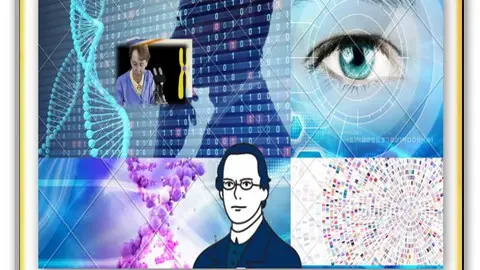Genetics From Mendel To Era Of Microarray Classical Genetics
Published 6/2023
MP4 | Video: h264, 1280x720 | Audio: AAC, 44.1 KHz
Language: English | Size: 1.81 GB | Duration: 2h 50m
Published 6/2023
MP4 | Video: h264, 1280x720 | Audio: AAC, 44.1 KHz
Language: English | Size: 1.81 GB | Duration: 2h 50m
Genetics principales and Applications
What you'll learn
introduction to genetic as science influence every day life
Genetic material and replication
Gene expression transcription and translation
DNA mutation and repair
regulation of gene expresion
Requirements
biology background
Description
the science of heredity. Genetics is concerned primarily with understandingbiological properties that are transmitted from parent tooffspring. The subject matter of genetics includes hered-ity, the molecular nature of the genetic material, the waysin which genes (which determine the characteristics oforganisms) control life functions, and the distributionand behavior of genes in populations.Genetics is central to biology because gene activityunderlies all life processes, from cell structure and function to reproduction. Learning what genes are, how genes are transmitted from generation to generationhe principles of heredity were not understood untilthe mid-nineteenth century, when Gregor Mendel ana-lyzed quantitatively the results of crossing pea plants thatvaried in easily observable characteristics. He publishedhis results, but their significance was not realized in hislifetime. Several years after his death, however, re-searchers realized that Mendel had discovered fundamental principles of heredityThe structure of DNA was first described in 1953, andsince that time genetics has become one of the most excit-ing and ground-breaking sciences. Our understanding ofgene structure and function has progressed rapidly sincemolecular techniques were developed to clone or amplifygenes, and rapid methods for sequencing DNA becameavailable.Research in genetics underwent a revolution in 1972,when Paul Berg constructed the first recombinant DNAmolecule in vitro, and in 1973, when Herbert Boyer andStanley Cohen cloned a recombinant DNA molecule forthe first time. The development by Kary Mullis in 1986of the polymerase chain reaction (PCR) to amplifyspecific segments of DNA spawned another revolution.Recombinant DNA technology, PCR, and other moleculartechnologies are leading to an ever-increasing number ofexciting discoveries that are furthering our knowledge ofbasic biological functions and will lead to improvementsin the quality of human life. In recent years, the sequencing of the genomes ofa large number of viruses and organisms has changed thescope of experiments performed by geneticists. For example, we can study a genome’s worth of genes now in oneexperiment, allowing us to obtain a more complete understanding of gene expression.understanding of the abstract nature of genes (fromthe transmission genetics part) with the molecular natureof genes (from the molecular genetics is one of the best approachClassic Principles.classic experiments, a number of which have led to discoveriesThese experiments include:•Griffith’s transformation experiment•Avery and his colleagues’ transformation experiment•Hershey and Chase’s bacteriophage experiment•Meselson and Stahl’s DNA replication experiment•Beadle and Tatum’s one-gene–one-enzyme hypothe-sis experiments•Mendel’s experiments on gene segregation•Thomas Hunt Morgan’s experiments on gene linkage•Seymour Benzer’s experiments on the fine structureof the gene•Jacob and Monod’s experiments on the lac operonThe Subdisciplines of GeneticsGeneticists often divide genetics into four major subdis-ciplines:1. Transmission genetics (sometimes called classicalgenetics) is the subdiscipline dealing with how genesand genetic traits are transmitted from generation togeneration and how genes recombine (exchange be-tween chromosomes). Analyzing the pattern of traittransmission in a human pedigree or in crosses of ex-perimental organisms is an example of a transmis-sion genetics study.2. Molecular genetics is the subdiscipline dealing withthe molecular structure and function of genes. Ana-lyzing the molecular events involved in the genecontrol of cell division, or the regulation of expres-sion of all the genes in a genome, are examples ofmolecular genetics studies. Genomic analysis is partof molecular genetics.3. Population genetics is the subdiscipline that studiesheredity in groups of individuals for traits that are de-termined by one or only a few genes. Analyzing thefrequency of a disease-causing gene in the human pop-ulation is an example of a population genetics study.4. Quantitative genetics also considers the heredity oftraits in groups of individuals, but the traits of concernare determined by many genes simultaneously. Analyz-ing the fruit weight and crop yield in agriculturalplants are examples of quantitative genetics studies.
Overview
Section 1: introduction
Lecture 1 intro
Lecture 2 introd lect2
Lecture 3 lect3
Lecture 4 intrduction4
Lecture 5 course introduction
Section 2: Introduction some Genetics concepts simply explaines
Lecture 6 what is DNA?
Lecture 7 what is chrmosome
Lecture 8 what is Gene ?
Lecture 9 what define our trait?
Lecture 10 Mitosis
Lecture 11 meiosis
Lecture 12 Meiosis Vs Mitosis
Lecture 13 cell cycle
Lecture 14 meiosis
Lecture 15 control of the cell cycle
Lecture 16 Genetic materials Early Experiments
Lecture 17 Genetic material structure
Lecture 18 DNA synthesis
Lecture 19 Telomere Telomerase 1
Lecture 20 Telomere Telomerase lect2
Lecture 21 Transcription
Lecture 22 Gene Expression translation introd
Lecture 23 gene expression translation
Lecture 24 Translation
Lecture 25 DNA replication
Lecture 26 control of Gene transcription
Lecture 27 gene regulation in prokaryote
Section 3: gene function
Lecture 28 Gene function gene control protein synthesis
Lecture 29 Human genenetic disorders
Lecture 30 Beta thalassemia
Section 4: Genetic engineering
Lecture 31 First Genetic engineering experiment
Lecture 32 DNA transformation
Lecture 33 T2 phage infect E coli
Lecture 34 PCR
Lecture 35 DNA microchip array
Lecture 36 Reverse transcription polymerase chain reaction RTPCR
biology students, medical students , any one interested in genetics



